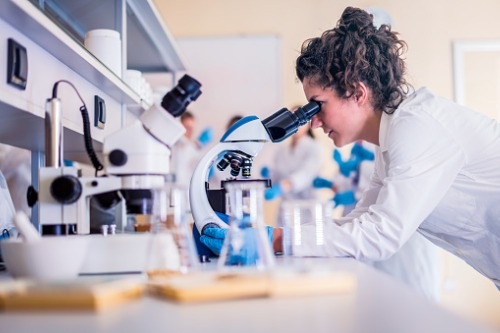HDI Global celebrates over 200 years of vaccine evolution

Authored by Tanya Patel, Life Sciences Underwriter, HDI Global SE UK
During the current pandemic, news headlines have been dominated by the development of COVID-19 vaccines and the vaccination roll-out.
To celebrate British Science Week, HDI have taken a look at the history of vaccines and how they have changed, and will continue to change, life in the UK.
Variolation to Vaccination
The word “vaccine” itself stems from the Latin word “vacca” meaning cow, and provides a clue to the origins of the modern day vaccine and the field of immunology. In 1796, British physician Edward Jenner theorised that cowpox, a mild virus that spread from cattle, was protecting dairy farmers from the potentially fatal or life-changing virus – smallpox. Jenner extracted pus from cowpox lesions to inoculate research subjects, and noted they did not develop smallpox upon exposure to the more deadly virus.
Prior to Jenner’s discovery, the British population relied on the variolation technique for protection against smallpox. English aristocrat, Lady Montagu, first learnt of this technique whilst in Turkey, and became an advocate for its use in the UK. Variolation involves inoculating a person with the smallpox virus itself, taken from a smallpox patient or a recently variolated individual, in the hope that the person will experience a mild infection that will provide immunity in future. Lady Montagu experienced strong opposition as 1–2% of those variolated died as a result. This was despite the 30% fatality rate amongst those who contracted smallpox naturally.
The British government introduced the British National Vaccine Act in 1840, which sought to make variolation illegal in favour of the safer vaccination process; a move that was celebrated by medical professionals. The Act was amended throughout the 19th Century, eventually making vaccination of children against smallpox compulsory. The Act included a “Conscience Clause” for parents that believed the vaccine to be unsafe or ineffective. This clause eventually gave rise to the term “conscientious objector” to describe those seeking exemption from military service on moral grounds.
The term “vaccine” originally referred to protective inoculations for smallpox only, however in 1881 it was proposed this term be expanded to a variety of new preventive treatments in honour of Jenner’s efforts.
An Explosion in Scientific Knowledge
It was supposedly an accident that led French microbiologist Louis Pasteur to the realisation that diseases could be artificially attenuated. Pasteur had been introducing chickens to fresh cultures of Fowl Cholera, usually resulting in their deaths, when he chose to take a vacation and complacently left cultures of the bacteria exposed to air for about a month. Upon returning to the lab, Pasteur exposed the chicken to the bacteria which were now weakened. To his surprise, the chickens did not die as expected, and even more surprisingly the chickens had developed a protective immunity to the same potent culture that previously would have caused death. This realisation that the bacteria had been weakened by its exposure to air eventually led Pasteur to develop other live-attenuated vaccines such as an anthrax vaccine in 1881 and a rabies vaccine in 1885.
Right at the turn of the 19th century, a new form of vaccine was developed: Inactivated or “killed” vaccines. These vaccines focused on preventing cholera, typhoid and the plague – three of the biggest killers of the time. In contrast to Pasteur’s research where pathogens were alive but weakened, this type of vaccine involved pathogens killed using methods such as heat, radiation or formaldehyde.
Around the same time in Germany, physicians Ehrlich and Behring first noted the existence of toxoids. Certain illnesses are caused by the toxins produced by bacteria, rather than the bacteria themselves, and it is possible for these toxins to be inactivated or weakened to create vaccines. This initial observation was built upon, eventually resulting in the development of the tetanus and diphtheria vaccines in 1926 and 1946 respectively.
Thanks to the explosion in scientific knowledge and vaccine introduction in the first half of the 20th century, there has been a marked reduction in the incidence of diseases that previously caused widespread death and disability in the UK. The establishment of the NHS in 1948 played a crucial role in mass vaccination programmes in the UK. Within two years of its establishment the NHS was routinely vaccinating children against whooping cough, tuberculosis, smallpox and diphtheria, and since this time the NHS childhood immunisation programme has only increased in scope. Since the introduction of the diphtheria and measles vaccines in the UK, cases have reduced by 99.9%, and cases of whooping cough by 96% since the vaccine’s introduction.
In the early 1950s, Europe and the US were rocked by major polio epidemics, for which there was no vaccine and no cure. Most people with polio experienced mild or no symptoms, but for some who developed muscle weakness and paralysis, the disease could be life-altering or fatal. Reminiscent of the current day, parents remember being scared to allow their children to play with friends or visit swimming pools and cinemas, for fear that their child would contract the feared disease. Pictures of rows of children completely encased in “iron lungs”, a type of ventilator that allowed patients to breathe despite lung muscle paralysis, created an atmosphere of heightened fear.
A race was on to develop the first polio vaccine. The contenders were Jonas Salk, an American virologist focused on developing a fully inactivated virus that was still able to produce protective antibodies, and Albert Sabin, a Polish-American researcher focused on producing a live-virus vaccine. Both approaches had their merits and downsides. Salk’s vaccine was simpler and potentially safer as a “killed” virus is unable to revert to its virulent state and cause harm, but the inactivated virus produces a weaker immune response than live viruses. In contrast, Sabin’s vaccine had the potential to produce a stronger immune response and longer lasting immunity, and also had the potential for excreted weakened virus to immunise the non-vaccinated population, giving communities widespread protection.
In the end, Salk’s vaccine was the first to market and the NHS began routine vaccination against polio with the inactivated virus in 1956. This was replaced in 1962 by the live attenuated polio vaccination, best known for being given to children orally on a sugar cube. As a direct result of Polio vaccination efforts there have been no domestically acquired cases of Polio, once the most feared of diseases, in the UK since 1982.
Modern Vaccination and Disease Eradication Efforts
Today, our planet is 99% of the way towards eradicating polio globally, thanks in part to the efforts of the Global Polio Eradication Initiative. The World Health Organisation (WHO) is confident that, unlike the majority of diseases, Polio can be completely eradicated as none of the 3 strains of wild poliovirus can survive long outside the body and a cheap oral vaccine exists, which means this can be administered by anyone and reach every child. If Polio is successfully eradicated, this will only be the 3rd disease to reach eradication status after smallpox in 1980 and the cattle disease Rinderpest in 2011.
Disease eradication, a permanent and global eradication of the disease, depends on multiple inter-connected economic, social and political factors and requires global coordination of efforts. As a result, disease elimination, reducing the incidence of a disease to zero in a particular geography, is thought to be more attainable and remains a first step towards disease eradication. To this end, 2010 to 2020 was declared by the WHO as the “Decade of Vaccines” aiming to deliver universal access to immunisation and in 2012, the United Nations Foundation launched the Shot@Life campaign to provide access to lifesaving vaccines for children in developing countries.
In developed countries, the great progress made throughout the 20th century is now under threat, as vaccine complacency and vaccine hesitancy could lead to vaccination rates falling below critical thresholds needed to protect the population as a whole. In fact, the WHO recently listed vaccine hesitancy as one of their top 10 greatest threats to global health, and the UK lost its measles eradication status in 2019 along with 3 other European nations as a result of vaccination rates falling below the 95% needed to maintain protection.
Despite these setbacks, the future looks bright for vaccination efforts, with recent studies suggesting 69 million lives will be saved globally between 2000 and 2030 as a result of vaccination against 10 major diseases, with the greatest impact on children under 5.
Current Research and Future Developments
Over the past two decades molecular genetics has been applied to vaccinology, resulting in a number of new vaccine delivery systems, including DNA vaccines, viral vectors and plant vaccines.
Many of these newer developments have been applied to the COVID-19 vaccine search, but the most exciting and unusual is the application of plant-derived technologies by Canadian company Medicago. With this technology the genetic sequence coding for a particular protein (in this case the S-spike protein of the novel coronavirus) is transferred to the leaf tissue of a tobacco plant, and over the course of a few days the proteins accumulate within the leaf tissue, with the plant essentially acting as a natural bioreactor. The leaves are then collected and the proteins are extracted and purified using conventional pharmaceutical techniques for the production of vaccines. These proteins are virus-like particles (VLPs) which imitate the structure of proteins found in viruses, resulting in an immune response. One of the greatest benefits of this technology is that large amounts of vaccine can be produced economically and quickly, as protein production can begin within just a few weeks of the genetic sequence of a pathogen being isolated and green-house based manufacturing facilities for the carrier plants can be rapidly established and scaled-up. As a result, this novel class of vaccines has great potential for future emerging health threats.
Whilst the world is currently preoccupied with infectious diseases, members of the Association of the British Pharmaceutical Industry (ABPI) are conducting cutting-edge research in a wide-array of areas. Of the 260 new vaccines in development, only half are targeting infectious diseases, with the remainder being developed for a whole range of medical conditions from cancers to allergies to Alzheimer’s diseases. Research is not only focused on the discovery and development of new vaccines themselves; invaluable research is also being conducted into vaccine adjuvant technologies. Adjuvants are substances administered at the same time as an antigen, and enhance the body’s immune response to that antigen. As a result, these technologies have the potential to improve efficacy, provide longer lasting immunity and reduce the amount of antigen needed per dose. This last point will be pertinent during this pandemic and any future health crisis, when vaccine demand is very concentrated, as more doses can be created and more people protected from less material.
Final Thoughts
Recent events have naturally highlighted the need to effectively monitor novel viruses, and ensure technology, manufacturing and logistics capabilities exist to respond to emerging threats. However, recent events should not distract the world from the near-constant effort and progress that has been made over the past century. It cannot be forgotten that continuing research into longstanding illnesses and continuing vigilance with childhood and adult vaccination programs, will be critical to controlling, preventing resurgence of and potentially eradicating many preventable existing diseases.
About HDI Global SE
Companies from the trading, production and service industries need an insurance partner they can rely on.
As part of the Talanx Group, HDI Global SE has been one of the leading insurers offering a broad and needs-based range of insurance solutions and accompanying services for decades.
HDI operates through foreign branches, subsidiaries and affiliates as well as network partners in more than 150 countries, offering international industrial insurance programmes.

